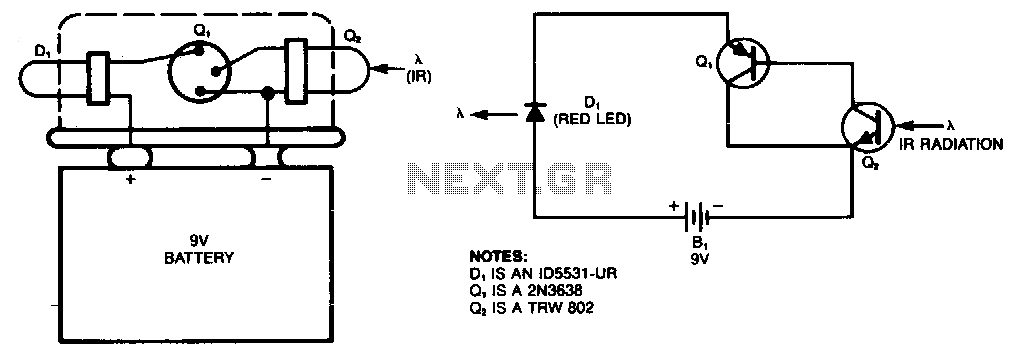
Simple-ir-detector

This simple infrared (IR) detector activates a red LED when the transistor Q2 is exposed to invisible IR radiation, commonly found in fiber-optic systems, position sensors, and TV remote-control units. The device can be constructed using a 9V battery and secured in place with RTV (Room Temperature Vulcanizing) silicone. Its power dissipation is nearly negligible unless it detects IR radiation or experiences high ambient light conditions. Normal fluorescent lighting does not interfere with its operation; however, an IR filter may be added to the Q2 detector to minimize the impact of ambient light. Additionally, exposing the detector to a strong light or IR source allows for a quick verification of both the battery and the red LED functionality.
The IR detector circuit consists of a few key components, primarily focusing on the transistor Q2, which serves as the active sensing element. When IR radiation is detected, the transistor enters conduction, allowing current to flow through the LED, illuminating it. The circuit can be designed with a resistor in series with the LED to limit the current and prevent damage to the LED.
The use of a 9V battery as the power supply is ideal for providing sufficient voltage to the circuit while maintaining a compact design. The battery can be connected directly to the collector of Q2, with the emitter connected to ground through a resistor. The base of the transistor is connected to the IR detector, which could be a photodiode or phototransistor sensitive to infrared light.
In environments with potential interference from ambient light, the addition of an IR filter is crucial. This filter can be a simple piece of plastic that only allows IR wavelengths to pass through while blocking visible light, thus enhancing the detector's sensitivity and accuracy.
For testing purposes, a strong IR source, such as an IR LED or a remote control, can be used to verify the functionality of the circuit. When the detector is exposed to this source, the LED should light up, confirming that the circuit is operational. This feature not only serves as a diagnostic tool but also ensures that the device is functioning correctly before deployment in practical applications.
Overall, the simplicity and effectiveness of this IR detector make it suitable for various applications, including remote control systems, position sensing, and any scenario where the detection of invisible IR radiation is necessary.This simple IR detector turns on a real LED when Q2 is exposed to invisible IR radiation found in fiber-optics systems, position sensors, and TV remote-control units. The device can be built on top of a 9V battery and held in place with RTV. Its power dissipation is virtually zero, unless IR radiation or high ambient light is present. Normal fluorescent lighting is not a problem, but if necessary add an IR filter to the Q2 detector to exclude ambient light.
Exposing the detector to a strong light or IR source gives a quick check of the battery and the red LED. 🔗 External reference
The IR detector circuit consists of a few key components, primarily focusing on the transistor Q2, which serves as the active sensing element. When IR radiation is detected, the transistor enters conduction, allowing current to flow through the LED, illuminating it. The circuit can be designed with a resistor in series with the LED to limit the current and prevent damage to the LED.
The use of a 9V battery as the power supply is ideal for providing sufficient voltage to the circuit while maintaining a compact design. The battery can be connected directly to the collector of Q2, with the emitter connected to ground through a resistor. The base of the transistor is connected to the IR detector, which could be a photodiode or phototransistor sensitive to infrared light.
In environments with potential interference from ambient light, the addition of an IR filter is crucial. This filter can be a simple piece of plastic that only allows IR wavelengths to pass through while blocking visible light, thus enhancing the detector's sensitivity and accuracy.
For testing purposes, a strong IR source, such as an IR LED or a remote control, can be used to verify the functionality of the circuit. When the detector is exposed to this source, the LED should light up, confirming that the circuit is operational. This feature not only serves as a diagnostic tool but also ensures that the device is functioning correctly before deployment in practical applications.
Overall, the simplicity and effectiveness of this IR detector make it suitable for various applications, including remote control systems, position sensing, and any scenario where the detection of invisible IR radiation is necessary.This simple IR detector turns on a real LED when Q2 is exposed to invisible IR radiation found in fiber-optics systems, position sensors, and TV remote-control units. The device can be built on top of a 9V battery and held in place with RTV. Its power dissipation is virtually zero, unless IR radiation or high ambient light is present. Normal fluorescent lighting is not a problem, but if necessary add an IR filter to the Q2 detector to exclude ambient light.
Exposing the detector to a strong light or IR source gives a quick check of the battery and the red LED. 🔗 External reference